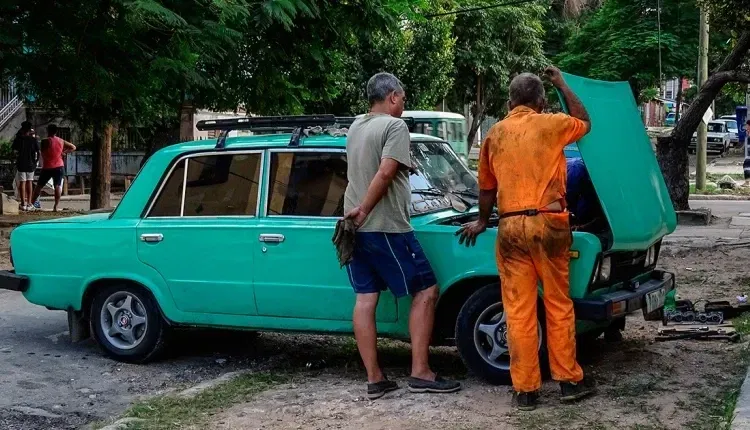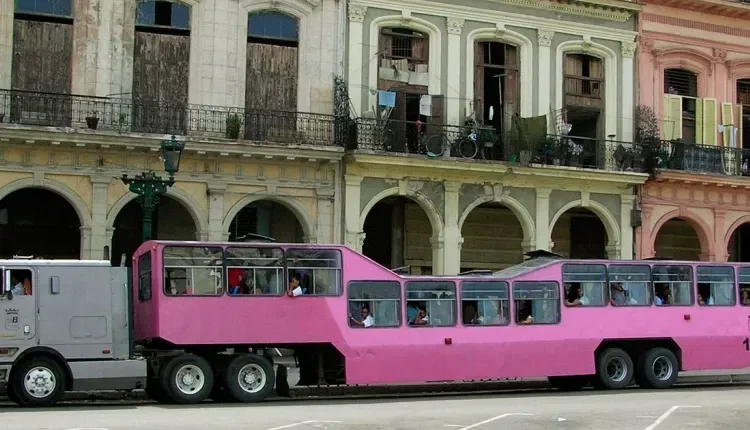





Our country is perhaps the only place in the world where classic American cars from the 1950s are still intact.
Old cars from Cuba
One of the most recognized images of Havana is the one that shows the National Capitol as a backdrop for an authentic collection of cars from the 1950s.
And our country Cuba is perhaps the only place in the world where classic American cars from the 1950s are still intact and sharing the road with an amalgam of very exotic vehicles.
Visitors from different origins admire the fascinating and heterogeneous concert of cars that the Cuban streets exhibit. Today we propose a closer look at five of these rarities that the city arteries of the Greater Antilles keep.
1- The Almendrones
On our island, all American cars imported before 1960 are called almendrones. Among these true gems are very exclusive models of the Pontiac Chevrolet, Buick, Ford, Cadillac, Dodge and Chrysler brands.
These cars arrived in Cuba before and during the government of Fulgencio Batista, who had many businesses with important American companies. For the upper class of Havana, it was very easy to get hold of the car of the moment and send for it to Florida.
Without intending to, this would end up creating one of the most representative icons of the island of Cuba, when 60 years later, popular inventiveness and necessity have kept these cars standing by renaming them as almendrones.
2- Fotingos
And if you thought it was a real rarity to find cars from the 50s, then sit down! Or you might fall down when you read what follows: In Cuba there are even older cars!
Cubans usually call Fotingos those cars from the beginning of the 20th century that are still circulating in our streets, although in smaller numbers than the aforementioned almendrones. But where did this word come from? We will tell you.
In 1908, the Ford Motor Company of the United States brought out its famous Ford Model T, which incorporated the three-pedal system: with clutch, brakes and accelerator. The company sold this novelty as the "foot it and go" system, that is, step on it and start it.
Needless to say, we immediately simplified the phrase into a single term, calling them fotingos, and by extension all the foreign cars that were coming in. Over time, and with the avalanche of new models in the following years, the word acquired a pejorative meaning when it began to designate older and obsolete automobiles.
3- The Camels
These vehicles are called indistinctly Superbus, Metrobús or Tren-bús, depending on the area of Cuba where they operate. Any of these terms would serve to designate them but they are more popularly recognized as camels.
This is an invention that arose in the so-called Special Period, a stage that began after the collapse of the Soviet Union, and which meant the loss of Cuba's main trading partners and consequently the supply of parts, equipment and fuel.
This artifact was built by reusing two buses from the Soviet era and joining them together on a truck trailer, to increase its capacity and accommodate more than 300 passengers. Although at one time they were the absolute protagonists of our streets, today they are beginning to disappear.
4- Ladas
After 1959, the Lada brand became the queen of Cuban streets and the symbol of modernity among Cubans thanks to the Soviet Union. The Lada, in its Cuban version, is a very durable and easy-to-repair vehicle, qualities that made it ideal for the hot and almost always damaged avenues of Cuba.
It is the most abundant car in our country, and the one most frequently used by state-owned companies. Even the Cuban motorized patrol uses Lada vehicles from the 1980s.
Just a week ago, new Lada models began to arrive in Cuba.
5- The Polaquitos
This is a mini-car produced in Poland at the FSM factory in Poland between 1973 and 2000. It was created as a licensed copy of the Italian Fiat 126, but it is called "Polski" by adding the letter "p" to differentiate it from other models manufactured in Europe. However, Cubans immediately called them "polaquitos".
Although this miniature car was never very popular with Cubans, it was a source of joy when a worker was assigned one based on his work merits. Over time, and despite their lack of popularity, the so-called "polaquitos" came to alleviate the difficulties posed by the special period, and they still travel around the different Cuban streets today.
What do you think?
Nuestro país es quizás el único lugar del mundo donde los coches clásicos americanos de la década del 1950 siguen intactos .
Carros antiguos de Cuba
Una de las más reconocidas estampas habaneras es la que muestra al Capitolio Nacional como telón de fondo para una auténtica colección de autos rodantes de los años 50.
Y es que nuestro país Cuba es quizás el único lugar del mundo donde los coches clásicos americanos de la década del 1950 siguen intactos y compartiendo vía con una amalgama de vehículos bien exóticos.
Visitantes de disímiles procedencias observan admirados el fascinante y heterogéneo concierto de carros que exhiben las calles cubanas. Hoy te proponemos precisamente un acercamiento a cinco de esas rarezas que guardan las arterias citadinas de La Mayor de Las Antillas.
1- Los Almendrones
En nuestra isla se le llama almendrones a todos los coches norteamericanos que fueron importados con anterioridad a 1960, entre estas verdaderas joyas se encuentran modelos muy exclusivos de las marcas Pontiac Chevrolet, Buick, Ford, Cadillac, Dodge o Chrysler.
Estos autos llegaron a Cuba antes y durante el gobierno de Fulgencio Batista, quien tenía muchos negocios con importantes compañías norteamericanas. Para la alta burguesía habanera era muy fácil acceder al coche del momento y mandarlo a buscar a la Florida.
Sin pretenderlo, ello terminaría por fraguar uno de los iconos más representativos de la isla de Cuba, cuando 60 años después la inventiva popular y la necesidad han mantenido en pie estos autos rebautizándolos como almendrones.
2- Fotingos
Y si te parecía una verdadera rareza encontrar coches de los años 50, pues ¡siéntate!, no sea que te caigas cuando leas lo que sigue: ¡En Cuba hay coches aún más viejos!
Los cubanos solemos llamar Fotingos a aquellos coches de inicios del siglo 20 y que aún se mantienen circulando en nuestras calles, aunque en menor proporción que los mencionados almendrones. Pero ¿de dónde vino esta palabra? Te lo contaremos.
En 1908, la Ford Motor Company de los Estados Unidos sacó su famoso Ford Modelo T, que incorporaba la modalidad del sistema de tres pedales: con embrague, frenos y acelerador. La compañía vendía aquella novedad como el sistema de "foot it and go", es decir, pisa y arranca.
No hace falta decir que enseguida simplificamos la frase en un solo término llamándoles fotingos, y por extensión a todos los carros extranjeros que iban entrando. Con el tiempo, y la avalancha de nuevos modelos en los años subsiguientes la palabra adquirió un significado peyorativo cuando comenzó a designar a los automóviles más viejos y obsoletos.
3- Los Camellos
Estos vehículos son llamados indistintamente Superbus, Metrobús o Tren-bús, según la zona de Cuba donde operan. Cualquiera de estos términos serviría para designarlos pero son más popularmente reconocidos como camellos.
Se trata de una invensión surgida en el llamado Período especial, etapa iniciada tras el colapso de la Unión Soviética, y que significó la pérdida de los principales socios comerciales de Cuba y por consiguiente de los suministros de piezas, equipos y combustible.
Este artefacto se construyó reutilizando dos autobuses de la época soviética y uniéndolos entre sí sobre un tráiler de camión, para aumentar su capacidad y acoger a más de 300 viajeros. Si bien en algún momento fueron los protagonistas absolutos de nuestras calles, hoy comienzan a desaparecer.
4- Los Ladas
Tras el año 1959 la marca lada se convirtió de la mano de la Unión Soviética en la reina de las calles cubanas, y el símbolo de la modernidad entre los cubanos. El Lada, en su versión cubana es un vehículo muy resistente y fácil de reparar, cualidades que lo hicieron ideal para las calientes y casi siempre dañadas avenidas de Cuba.
Se trata del carro que más abunda en nuestro país, y el que es usado con más frecuencia por las empresas estatales. Hasta la patrulla motorizada cubana se mueve en vehículos Lada de los años 80 del pasado siglo.
Hace justo una semana comenzaron a llegar los nuevos modelos Lada a Cuba.
5- Los Polaquitos
Se trata de un mini-coche producido en Polonia en la fábrica FSM en Polonia entre los años 1973 y 2000. Surgió como una copia bajo licencia del italiano Fiat 126, pero se le llama "Polski" adicionándole la letra "p", para diferenciarlo de otros modelos fabricados en Europa. Sin embargo, los cubanos enseguida los llamamos polaquitos.
Si bien este carro de miniatura nunca fue del mayor agrado para los cubanos, era motivo de alegría cuando a un trabajador le asignaban uno a partir de sus méritos laborales. Con el tiempo, y a pesar de su escasa popularidad, los llamados polaquitos vinieron a paliar las dificultades que planteó el período especial, y todavía hoy se mueven por las diferentes calles cubanas.
¿Qué opinas?
For the best experience view this post on Liketu
Congratulations @luixotorreblank! You have completed the following achievement on the Hive blockchain And have been rewarded with New badge(s)
Your next target is to reach 500 upvotes.
You can view your badges on your board and compare yourself to others in the Ranking
If you no longer want to receive notifications, reply to this comment with the word
STOPCheck out our last posts:
Very cool cars! I remember seeing lots of old cool cars when I was in Cuba. :)